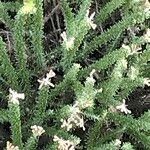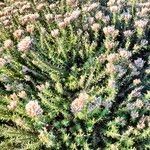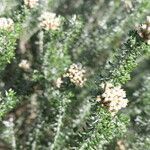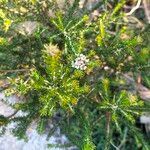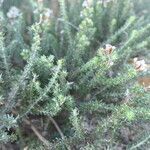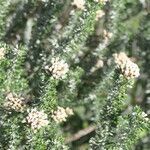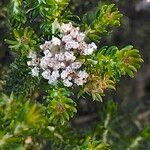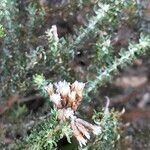Erect shrublet or shrub, sometimes compact, often robust, much to very much-branched, up to 3 m high. Branches erect, young densely whitish-tomentose, older becoming glabrous or subglabrous, with distinct leaf-scars. Foliage dense. Leaves spreading, apically curved to hooked, with axillary brachyblasts less than half as long as the subtending leaf, involute to much involute, narrowly oblanceolate to oblanceolate, or sometimes lanceolate, 2.6-9.0 x 0.4-1.5 mm, acute in outline, obtuse at the very apex, often carinate, half-twisted or twisted about once, slightly pubescent to glabrous, with a distinct midvein at least towards the base. Synflorescenses (5-)10-50 mm wide, dense, conspicuously branched, with often numerous capitula arranged in (few-)10-30 ± branched clusters, each containing few to numerous capitula; a few individually arranged capitula sometimes also present. Peduncles (0-)2-18 mm long. Capitula 4-5(-6)-flowered, sessile or with pedicels up to 5 mm long, free from one another, lower 3/5-3/4 of each capitulum hairy. Involucre narrowly cyathiform to very narrowly campanulate, apically 2-3 mm wide, sometimes up to 4 mm wide at anthesis. In vomeral bracts in (6-)7-9(-10) series, gradually longer inwards, outermost about 1/5-1/3 as long as the innermost, most bracts not petaloid, outermost subfoliaceous to scarious, those inwards more scarious to petaloid, outermost narrowly lanceolate to lanceolate, those inwards narrowly elliptic to narrowly oblanceolate, all except outermost with narrow hyaline margins and usually slightly transparent above the stereome, outermost acute, those inwards acute in outline but rounded at the very apex to entirely rounded or subtruncate and slightly dentate to emarginate, outermost to inner apically erect, innermost apically erect-spreading to erect and with slightly involute margins, all except innermost thick and faintly carinate, outermost with interlocking hairs reaching above the middle of the bract, those inwards less hairy to glabrous, outermost light to dark brown, those inwards yellowish-brown to creamy white to white, innermost with a stereome about 1-1.4 times as long as the lamina. Corolla narrowly cylindrical, 3.8-4.5 mm long, sometimes with a rigid resiniferous base; lobes erect. Anthers apically rounded to truncate. Cypselas narrowly oblong to narrowly oblong-ovoid, 1.5-1.9 mm long, without an annular ridge, with short acute papillae, brown. Pappus bristles with a slightly serrate to dentate, very narrow to narrow shaft, apically ± flattened and slightly serrate to entire, subterete or thickened towards the very apex, usually obtuse, sometimes with inconspicuous clavate cells.
More
Erect shrub, 0.5-3.0 m high. Leaves spreading, apically curved to hooked, with axillary brachyblasts less than half as long as subtending leaf, 2.6-9.0 mm long, obtuse at the very apex, with a half or full twist. Synflorescenses (5-)10-50 mm wide, dense, with capitula arranged in branched clusters. Capitula 4-or 5(6)-flowered, sessile or with pedicels up to 5 mm long, free from one another; involucre narrowly cyathiform; involucral bracts in (6)7-9(-10) series, most bracts not petaloid, all except innermost thick and faintly carinate, outermost with interlocking hairs reaching above middle of bract, light to dark brown, those inwards yellowish brown to creamy white to white. Flowering time mainly May-Sept. Pappus subterete or thickened towards the very apex, usually obtuse. Cypselae narrowly oblong, 1.5-1.9 mm long, with short acute papillae.
A low rounded shrub. It can grow to 4 m tall. The crown is made up of upward pointing twiggy stems. The leaves are very small and less than 1 cm long. They are often needle like. They occur in tufts on the branches. The flowers are in crowded heads at the ends of branches. The flowers have a honey smell.
Similar to M. densa but leaves hooked at tips, bracts brown, inner bracts thick and faintly keeled above.
